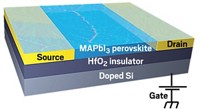Advertisement
Grab your lab coat. Let's get started
Welcome!
Welcome!
Create an account below to get 6 C&EN articles per month, receive newsletters and more - all free.
It seems this is your first time logging in online. Please enter the following information to continue.
As an ACS member you automatically get access to this site. All we need is few more details to create your reading experience.
Not you? Sign in with a different account.
Not you? Sign in with a different account.
ERROR 1
ERROR 1
ERROR 2
ERROR 2
ERROR 2
ERROR 2
ERROR 2
Password and Confirm password must match.
If you have an ACS member number, please enter it here so we can link this account to your membership. (optional)
ERROR 2
ACS values your privacy. By submitting your information, you are gaining access to C&EN and subscribing to our weekly newsletter. We use the information you provide to make your reading experience better, and we will never sell your data to third party members.
Electronic Materials
New design resurrects thermoelectrics once considered hopeless
No one thought this old class of highly efficient thermoelectrics could be used in a device
by Prachi Patel, special to C&EN
May 23, 2019
| A version of this story appeared in
Volume 97, Issue 21

Thermoelectric materials can generate power from waste heat and provide eco-friendly cooling. Researchers have now made an efficient thermoelectric power generator from a material that had been set aside as a reject decades ago (Joule, 2019. DOI: 10.1016/j.joule.2019.04.010). The material, which contains abundant, nontoxic elements and is more efficient than state-of-the-art thermoelectrics, could open up the technologies for broader use.
When two dissimilar thermoelectric solids are coupled, a temperature difference across the materials generates an electric current, and vice versa. Thermoelectric devices can take advantage of this to cool things down, heat them up, or generate electricity from heat. Expensive bismuth telluride-based alloys, lead selenide and other thermoelectrics are found in niche products such as climate-controlled car seats and systems that generate power from heat on distant spacecraft.
To find wider use, thermoelectric systems need to be more efficient, and their costs need to drop. But finding the right materials to make this possible has been a challenge. Researchers have been particularly tantalized by metallic compounds such as copper selenide and zinc antimonide, which boast some of the highest efficiencies of any thermoelectrics. In these materials, ions flow fast and free, just as they do in liquids. This becomes a liability in a thermoelectric module: the free-flowing ions deposit on the electrode and ruin the device after just a few hours. For that reason, no one has had luck making devices with these compounds.
Now, a group has found a simple solution. Researchers led by Xun Shi and Lidong Chen of the Chinese Academy of Sciences and G. Jeffrey Snyder of Northwestern University found a clever workaround that lets them use copper selenide in an efficient thermoelectric module that runs for at least 400 hours. The secret is to keep the voltage at which the module operates below a certain threshold. This keeps the metal ions from depositing on the electrode and the device stays stable.
To make the device work at this lower, more stable voltage, they carefully optimized the geometry of the two different pieces that are coupled to make the module. As in conventional modules, the operating voltage depends on the current that flows across the two thermoelectric “legs”—in this case, one made of copper selenide and the other of a cobalt-antimony compound. By making the copper selenide leg larger by a calculated amount, the researchers optimized the current density across the two legs so that the operating voltage remains low.
“Copper selenide has historically been considered useless for applications,” says Mercouri G. Kanatzidis, a chemist at Northwestern University who was not involved in the work. The strategy of controlling voltage does not solve the fundamental problem of the material being susceptible to copper deposition. “In a way, they haven’t cured the disease but they have found a way to manage it very well,” he says.
The module converts 9% of the energy in the heat it absorbs into electricity, a big improvement over the 6% efficiency of previous thermoelectric generators. “This is a really impressive value for energy conversion,” says Ctirad Uher, a physicist at the University of Michigan. The devices are far from practical use—in real systems, they would need to last for months. But he says this is an excellent first prototype.
Both materials in the new module work at high temperatures, making them suitable for waste-heat recovery. But Snyder says the team’s design could have other uses. The module “opens the door to looking at other liquid-like materials such as zinc antimonide that could work at room temperatures for cooling,” he says, though this will require further improvements in the materials’ efficiency.





Join the conversation
Contact the reporter
Submit a Letter to the Editor for publication
Engage with us on Twitter